Lenten rose, Helleborus orientalis
…Sweet April! Many a thought
Is wedded unto thee, as hearts are wed…
-Longfellow
Henry Wadsworth Longfellow (1807-1882) lived for four-and-a-half-decades just a mile away from Mount Auburn, experiencing many a sweet April day. Presumably he also didn’t put away his winter coat too early, knowing of variable winter-like weather still possible, despite science defining the beginning of spring for us with the vernal equinox (March 20). Locally, we have experienced snowfall on the running of five Boston Marathons (1907, 1908, 1925, 1961, and 1967), which occurs in the third week of April and two Boston Red Sox games in Fenway Park were snowed out on April 8th and 10th in 1996. Boston had a half-inch of snow on May 10, 1977. We also had the 1997 April Fool’s Day Blizzard which dropped two-feet of wet, heavy, snow on Boston.
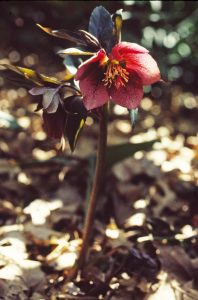 Lenten rose, Helleborus orientalis and Helleborus xhybridus some years may begin flowering during late-March’s warming rays of sun, while being tough enough to withstand winter’s final frost and snowfall. Despite the common name, these are not roses, in fact they are not even in the rose family, ROSACEAE. The flowers however do have in their shape, a slight resemblance to a small five-petal rose. The genus Helleborus includes 15-20 species within the RANUNCULACEAE, the crowfoot or buttercup family. The genus name was purportedly given by Hippocrates (c.460-c.377 BCE), the “father of modern medicine” who also developed a listing of hundreds of medicinal plants. Helleborus is derived from the Greek words ‘helein’, to injure, and ‘bora’, food, alluding to the bitter leaves and roots which contain toxins.
Lenten rose, Helleborus orientalis and Helleborus xhybridus some years may begin flowering during late-March’s warming rays of sun, while being tough enough to withstand winter’s final frost and snowfall. Despite the common name, these are not roses, in fact they are not even in the rose family, ROSACEAE. The flowers however do have in their shape, a slight resemblance to a small five-petal rose. The genus Helleborus includes 15-20 species within the RANUNCULACEAE, the crowfoot or buttercup family. The genus name was purportedly given by Hippocrates (c.460-c.377 BCE), the “father of modern medicine” who also developed a listing of hundreds of medicinal plants. Helleborus is derived from the Greek words ‘helein’, to injure, and ‘bora’, food, alluding to the bitter leaves and roots which contain toxins.
…leftover leaves in the corners
of the garden, a Lenten Rose
that thought it safe
to bloom so early.
-Linda Pastan
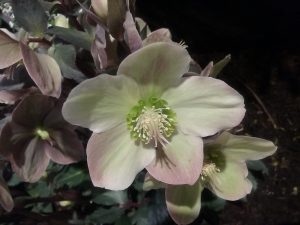 The flowers may be greenish cream, green and white, pink and green, burgundy red or hues of purple. The 15-18-inch upright stems hold the flowers, which often are nodding. The showy parts of the flowers are comprised of five 1 ½ -2 ½-inch sepals rather than petals. The inconspicuous petals are found inside, reduced to a ring of nectaries obscured by numerous yellow stamens. The long-lasting sepals may persist for several months. Lenten roses have been cultivated for centuries, but the more recent decades have produced an increasing number of cultivated varieties. Peter Loewer in his Tough Plants for Tough Places says, “The plants interbreed like the gods of ancient Greece…” In addition to an array of attractive sepals, many also include contrasting colorful dots, splotches and/or veining. Their leaves are glossy, leather-like with numerous fine serrations along the margin. These semi-evergreen or evergreen leaves may persist during a mild winter, but more frequently are mangled when buried beneath winter’s snow load. Early spring pruning enhances the floral display. Helleborus xhybridus, Lenten rose was designated the perennial plant of the year in 2005 by the Perennial Plant Association.
The flowers may be greenish cream, green and white, pink and green, burgundy red or hues of purple. The 15-18-inch upright stems hold the flowers, which often are nodding. The showy parts of the flowers are comprised of five 1 ½ -2 ½-inch sepals rather than petals. The inconspicuous petals are found inside, reduced to a ring of nectaries obscured by numerous yellow stamens. The long-lasting sepals may persist for several months. Lenten roses have been cultivated for centuries, but the more recent decades have produced an increasing number of cultivated varieties. Peter Loewer in his Tough Plants for Tough Places says, “The plants interbreed like the gods of ancient Greece…” In addition to an array of attractive sepals, many also include contrasting colorful dots, splotches and/or veining. Their leaves are glossy, leather-like with numerous fine serrations along the margin. These semi-evergreen or evergreen leaves may persist during a mild winter, but more frequently are mangled when buried beneath winter’s snow load. Early spring pruning enhances the floral display. Helleborus xhybridus, Lenten rose was designated the perennial plant of the year in 2005 by the Perennial Plant Association.
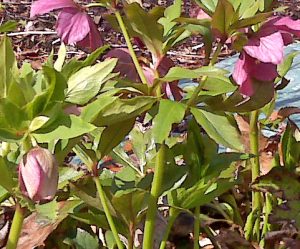 A different species Helleborus niger, Christmas rose is more common in milder climates, and blooms much earlier, hence its name. A whimsical Helleborus account based on a snippet of facts was relayed by the garden author Allen Lacey (1935-2015) in his 1981 Farther Afield. A winter visitor to Bressingham Nurseries, created by the famous gardener Alan Bloom (1906-2005), told how some hellebores growing in a fen that was flooded in winter to allow for family ice-skating created a reality of seeing hellebores blooming beneath the ice. Here Lacey elucidates, “I have no more of the story than that…I have only the barest of fact…my imagination has full rein-and reign-…and I dream my way into the story…told me in that bar in Columbus…That flooded fen covers twelve acres, all planted in Christmas and Lenten roses, as thickly as in a floral tapestry. The ice gleams in the sun…scores and scores of skaters…sounds of blades against the ice…I put on skates and join the others…I am lost in wonder as I glide across the ice, with the hellebores blooming below my feet, as still as flowers made of glass…”
A different species Helleborus niger, Christmas rose is more common in milder climates, and blooms much earlier, hence its name. A whimsical Helleborus account based on a snippet of facts was relayed by the garden author Allen Lacey (1935-2015) in his 1981 Farther Afield. A winter visitor to Bressingham Nurseries, created by the famous gardener Alan Bloom (1906-2005), told how some hellebores growing in a fen that was flooded in winter to allow for family ice-skating created a reality of seeing hellebores blooming beneath the ice. Here Lacey elucidates, “I have no more of the story than that…I have only the barest of fact…my imagination has full rein-and reign-…and I dream my way into the story…told me in that bar in Columbus…That flooded fen covers twelve acres, all planted in Christmas and Lenten roses, as thickly as in a floral tapestry. The ice gleams in the sun…scores and scores of skaters…sounds of blades against the ice…I put on skates and join the others…I am lost in wonder as I glide across the ice, with the hellebores blooming below my feet, as still as flowers made of glass…”
Here we must remind you that there is no actual ice-skating allowed at Mount Auburn (let your imagination reign), but on your next visit look for some of our blooming Helleborus in front of the administration building, in Birch Gardens, and on Holly Path among other locations.
…The fingers of the winter drip.
They weaken into water, as a heart
Melted by love. They are no longer cruel.
They change their mind, as wind has changed its mind…
-Vita Sackville-West
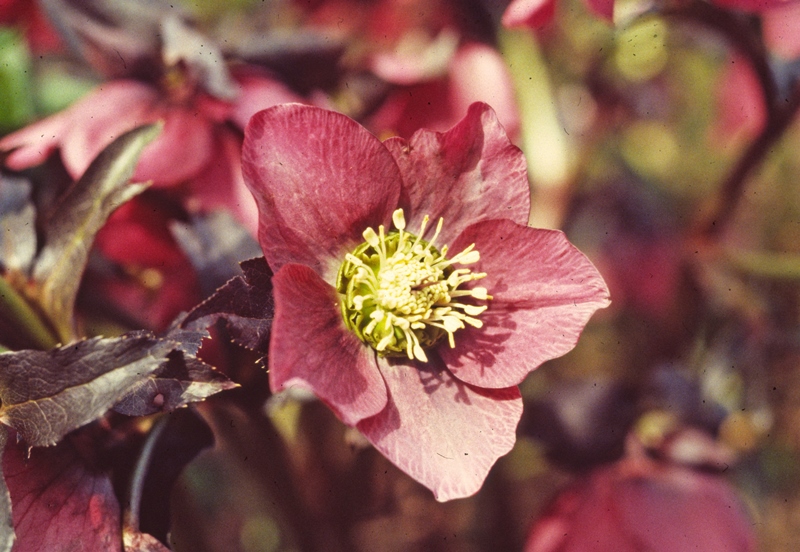
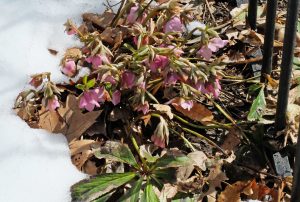
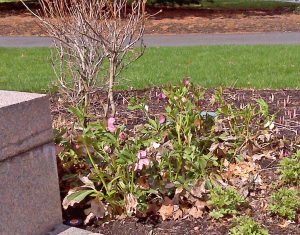
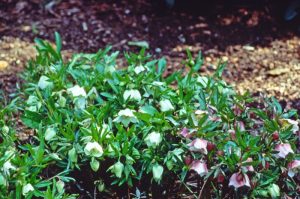
Leave a Reply